Wind industry to see rebound in 2022
06 April 2022
As oil prices reach record levels in the United States, the conversation about renewable energy sources is becoming more interesting and important. Wind power has long been a reliable power source, and while it can’t yet power automobiles or construction equipment, it can greatly reduce America’s dependence on fossil fuels.
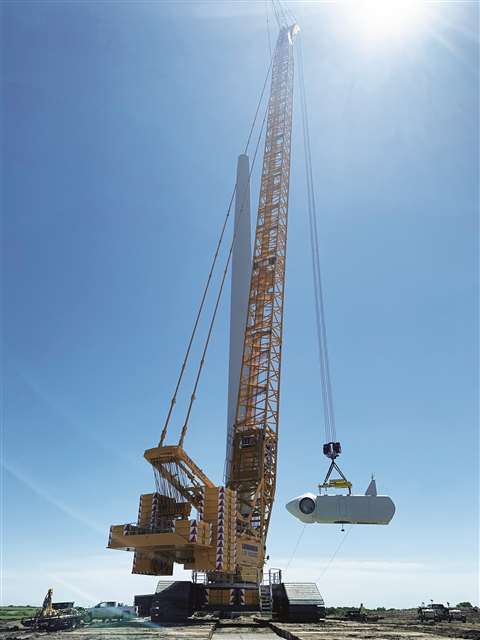 While 2022 is shaping up to be a banner year for the wind power market, crane and transport companies are concerned about supply chain interruptions and rising fuel and equipment costs.
While 2022 is shaping up to be a banner year for the wind power market, crane and transport companies are concerned about supply chain interruptions and rising fuel and equipment costs.
Due to the Covid-19 pandemic, the wind energy sector saw project delays and component shortages in 2020. In 2021, capacity levels rebounded quickly with record setting production. As for 2022, the major players in the wind industry are optimistic.
“We see 2022 as another strong year for new wind installation and repower projects, with an even larger rebound coming in 2023,” said Dan Ives, engineer and lift planner at Buckner HeavyLift. “Given recent global developments, transportation costs are likely to increase due to rising fuel prices and general uncertainty, so that market will likely experience some volatility.”
Imminent challenges?
Boss Crane & Rigging’s David Cowley said the 2022 wind market looks promising; however, he is concerned about supply chain interruptions and rising fuel and equipment costs.
“There may be delays in getting projects completed in addition to higher installation costs,” Cowley said.
Steve Burkholder manages wind farm projects performed by Lomma Crane & Rigging.
“If the production tax credits (PTCs) remain in effect, I believe it’s going to be a strong few years for the wind industry,” Burkholder said. “We already seeing a lot of work in the pipeline. On the East Coast, there’s a lot of opportunity for repair work this year.”
ML Crane Group’s Ben McKinstry, director of wind and renewables, said his company sees 2022 the same as 2021, with a slightly slower start.
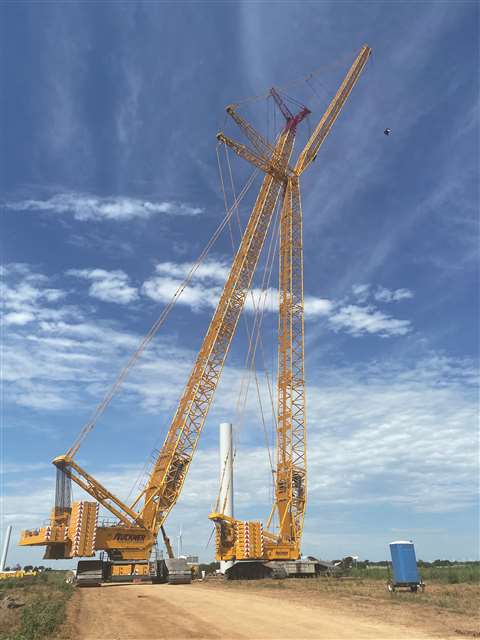 Working in the wind market requires a commitment to a fleet of certain types of cranes. This summer Buckner HeavyLift will have close to 80 percent of the company’s fleet working in the wind power market.
Working in the wind market requires a commitment to a fleet of certain types of cranes. This summer Buckner HeavyLift will have close to 80 percent of the company’s fleet working in the wind power market.
Rich Johnson, vice president of JMS Crane & Rigging, (a subsidiary of TNT Crane & Rigging), said his company is enthusiastic about policy advancements, as well as the continued transition into renewable energy.
“We believe this will ignite substantial growth through transmission investment and utility/commercial demand in the industry,” Johnson said. “Last year, nearly $80 billion was set aside to upgrade and expand the U.S. energy grid, which will resolve the capacity constraints that have limited wind projects from being built or expanded in the past. More than half of the U.S. states have mandated a renewable energy standard (RES) to transition to the generation of clean energy. Commercial and industrial customers year after year are transitioning to clean energy sources. Hence the ever-growing demand for clean power and the ability to fulfill and deliver those capacity needs signals a positive future for the wind market.”
He also added, “Unfortunately, our clients continue to experience supply chain issues, such as gear box availability, resulting in project delays. In our industry labor/talent shortages for field repair personnel persist.”
Working in the wind market requires a commitment to a fleet of certain types of cranes. Buckner HeavyLift has made this commitment in a big way. According to Ives, during the summer months, close to 80 percent of the company’s fleet will be working in the wind power market.
“Our Liebherr tele-crawlers, the LTR 1220 and LTR 1100, are very popular assist and tailing cranes on wind power projects,” Ives said. “As for main erection cranes, new installation projects will be dominated by the 1,000-metric ton Liebherr LR 11000, whereas repower projects will have a high demand for our fleet of 600-metric ton Liebherr LR 1600/2 crawler cranes.
Boss’s Cowley said his company’s fleet ranges from 100 up to 900-ton capacity cranes dedicated to the wind market.
“We have approximately 10 cranes solely dedicated to wind installation and warranty work,” he said.
Rising demand
Lomma’s crane fleet dedicated to the wind market fluctuates because demand keeps increasing.
“Right now, it’s about 15 percent allocated to the wind market,” said Burkholder.
He said Lomma’s wind cranes run the gamut – Manitowoc 16000s WAs and MLC650 wide booms, Manitowoc 18000, the Link-Belt TCC2500s and TCC 1100, Manitowoc 999 and Liebherr LR1300, plus some 90 to 150-ton rough terrains in the mix.
“We are allocating about 15 percent of our current fleet with more specific models on order,” said ML Crane Group’s McKinstry.
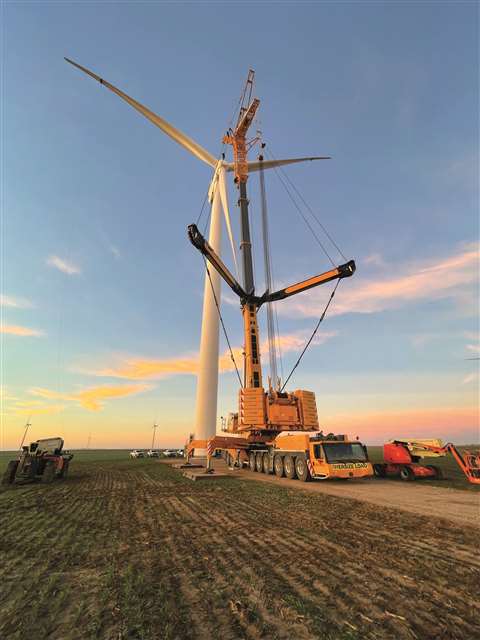 TNT operates about 30 Manitowoc and Liebherr cranes across the wind market.
TNT operates about 30 Manitowoc and Liebherr cranes across the wind market.
JMS Cranes and RMS Cranes (also subsidiaries of TNT Crane & Rigging) operates about 30 Manitowoc and Liebherr cranes across the wind market.
“Our fleet includes Manitowoc: MLC300, M16000, M18000, MLC650 and Liebherr: LTM1750, LTM1500, LR1600, LR1500, LTM1450, LTM1400, LTM1350, LTM1250, LTM1220, LTR1220 and LTR1100,” said Mike Appling, CEO of TNT.
As far as transporting wind components, Boss Crane, Lomma Cranes and ML Holdings also offer transportation of wind tower components.
Currently, Boss is hauling replacement parts, full turbines and repower parts. ML Holdings is currently hauling a lot of blades.
Heavier and higher turbines are a challenge that U.S. crane companies have met by purchasing longer reach and higher capacity cranes.
JMS’s Johnson said taller and heavier turbines do impact operations.
“Transport logistics have been impacted due to the fragmented permitting process,” Johnson said. “In addition, the U.S. infrastructure was not designed to accommodate these heavier and longer loads. The wind community’s logistical groups along with private transport companies are actively engaged in establishing standardized permitting requirements. Turbine suppliers are trying to address this issue by developing retractable blades and designing blades with curvature. It is extremely important for us to be exact in our planning process and route studies to overcome these issues.”
Supply and demand issues
The crane industry has been challenged with the development of bigger, heavier, taller units with bigger rotor diameters, he said.
“Unfortunately, there are a limited number of crane models that can be utilized for these jobs which creates supply and demand issues,” Johnson said. “Another challenge are project owner time constraints, as it takes more time to move the components as the crane configurations are more complex and heavier, which also leads to lengthier crane assembly and disassembly. At these new heights, wind speeds can affect lifting activities. Plus we encounter project terrain with confined pad space and environmental restrictions, all which can affect the schedule. Turbine manufacturers realize the limitations and have designed components that are split so they can be installed separately.”
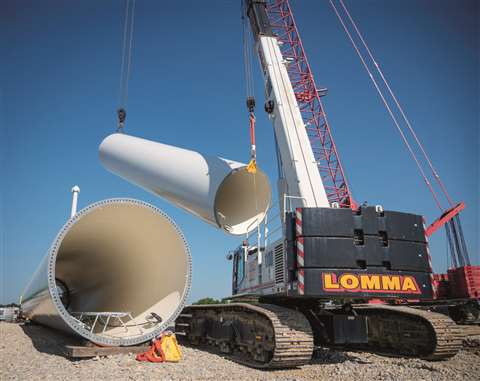 Lomma Crane & Rigging’s fleet dedicated to the wind market fluctuates because demand keeps increasing.
Lomma Crane & Rigging’s fleet dedicated to the wind market fluctuates because demand keeps increasing.
JMS recognizes the challenges and addresses them with its experienced operators that define the crane and boom configuration to ensure it will meet the capacity, Johnson said. JMS’s team vets projects prior to taking them on to ensure they can comfortably meet those timelines with the complexities involved.
“This trend continues apace,” said Buckner’s Ives. “Last year our cranes installed the first Vestas EnVentus wind turbines in North America, which have a rotor diameter of 162 meters, a hub height of 119 meters and a rated power output of 6 megawatts. For 2022, our current bookings for new installation will include more V162s, as well as the large 5 to 6 MW turbines offered by GE, Siemens Gamesa and Nordex. These turbines will have hub heights up to 120 meters, with single component lifts up to 230 metric tons, or well over 500,000 pounds.”
Wind work is Buckner’s bread and butter, according to Kevin Long, sales director of wind.
“No crane provider has more experience with the capacity and hook height requirements of the latest generation of wind turbines than Buckner,” said Long. “Regardless of the capacity and hook height needed, we approach each wind turbine type in a similar manner, determining the overall best crane option that will set our customers up to be efficient, productive and flexible.”
New platforms and heights greater than 100 meters limit the cranes available to complete the work, Cowley said.
“These larger cranes are more expensive to operate, more expensive to transport and add costs to the project for larger crane pads, wider crane walks, compaction requirements and the number of support vehicles needed to move the larger equipment,” said Cowley.
Getting bigger
Lomma’s Burkholder said wind turbines are increasing in size across the board.
“The challenges are when it comes to repairs on turbines above 100 meters because there aren’t a whole lot of hydraulic cranes that can do the repair work needed on anything above 100 meters,” he said. “Lead times on purchasing hydraulic cranes that can do this type of work are very long right now.”
ML Crane Group is procuring larger cranes and looking at alternative options in dealing with larger turbines and related components.
There are a handful of cranes that perform as the “main crane” on new wind farms that are under construction.
“When it comes to new installation, the LR 1600/2 has its role, as does the LR 1800, but far and away new installation is dominated by the Liebherr LR 11000,” said Buckner’s Ives. “For projects that are not conducive for crawling, we have the LG 1750, which offers high capacity and hook height while being able to move between wind turbines on narrow roads with appreciable grades.”
About 10 years ago, the new installation market shifted from the 440 to 500-ton class to the 600 to 700-ton class, Ives said.
“Over the last few years, a similar shift has been occurring, replacing the 600 to 700-ton class with the 900 to 1,000-ton class, and that shift is nearly complete,” Long said. “If we weren’t confident in that assessment, we wouldn’t have over 25 LR 11000s in our fleet.”
Burkholder said main cranes in Lomma’s fleet include the MLC650 wide boom, MLC 650 WA, Manitowoc 18000s, 16000s and the 16000WA, and for smaller turbines, the LR1300SX.
“We buy where the demand is, so if the demand is there, we’ll continue to invest in this area,” he said.
ML Holdings has several main cranes in the company’s fleet with more on order.
The current main crane models in TNT’s fleet are Manitowoc MLC300, M16000, M18000 and MLC650 and Liebherr LTM1750, LTM1500, LR1600, LR1500, LTM1450 and LTM1400. The company intends to expand its fleet with the growing wind market.
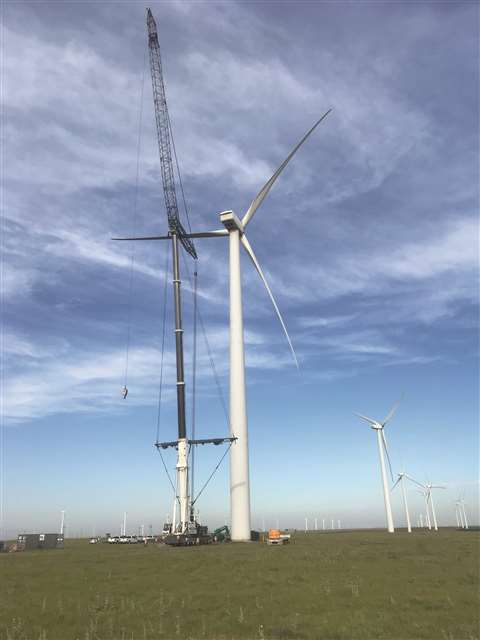 Boss Crane & Rigging has about 10 cranes dedicated to the wind power industry.
Boss Crane & Rigging has about 10 cranes dedicated to the wind power industry.
Maintenance market
Typical wind turbines need maintenance on a regular basis, and most need to be replaced after 20 years. This brings a lot more work to U.S. crane companies.
“We are involved in the maintenance of the wind farms and the repowers,” said Boss’s Cowley. “The advantages are that the turbines will always need maintenance just like any other power generating system, keeping cranes busy and men working.”
ML Crane Group primarily performs maintenance work.
“The advantage is there is plenty of maintenance work year round,” McKinstry said. “The disadvantage is mobilization costs for one off jobs, and the lack of trucks available with a much higher rate due to inflation costs.”
Burkholder said the challenge to maintenance work is project timing and lead times.
“We just need to buy bigger cranes as the turbines get bigger,” he said. “The advantage is we’re going to stay busy well into the future because of planned investments.”
Buckner supplies cranes for wind farm maintenance and the company anticipates growing this segment of the market.
“All of these wind turbines our cranes are installing with hub heights of 120 meters or more are going to require large component exchanges,” Ives said. “The capacity and hook height needs are going to challenge large hydraulic all-terrain cranes, but will be easily achieved by lattice boom cranes.”
JMS, RMS and TNT are involved in wind maintenance and have partnerships with several wind turbine manufacturers. With maintenance work, no matter what happens with tax credits, existing turbines still require work, Johnson said.
“For the last several years we have seen extreme growth in repowering existing turbines that are not necessarily at the end of their life cycle,” Johnson said. “A partial repower consists of replacing components to increase the hub height and rotor diameter to produce more energy. This is an attractive option for a project owner as wind turbine capacity declines every year due to mechanical aging. Repowering older units can increase capacity and improve reliability by taking advantage of new technology. It can also afford project owners to possibly take advantage of tax credits to offset costs. This is advantageous to us because projects are typically long-term with a larger scope. The most common challenge is not having a rigging procedure for obsolete turbine models. But we have always overcome this by engineering rigging methods.”
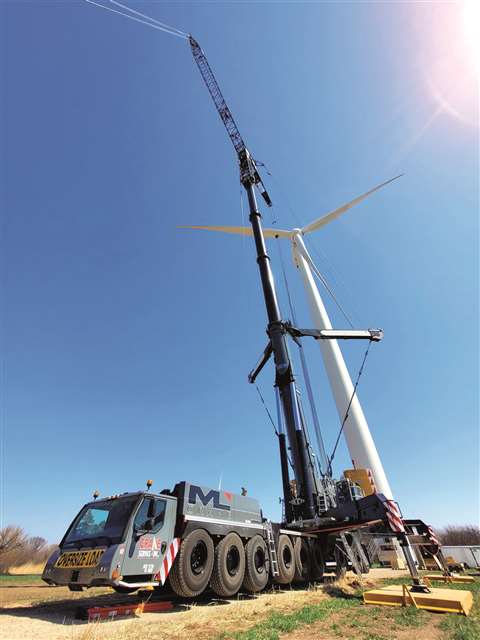 ML Crane Group allocates about 15 percent of its current crane fleet to wind power and the company has more cranes on order that are tagged for the wind market.
ML Crane Group allocates about 15 percent of its current crane fleet to wind power and the company has more cranes on order that are tagged for the wind market.
Offshore opportunities
Offshore wind farms are the wave of the future. Buckner HeavyLift plans to play an active role in this blossoming market.
“Due to the Jones Act, many offshore wind projects in U.S. waters will require the main installation vessel to have turbine components pre-assembled and shipped directly to it using feeder barges,” said Buckner’s Ives. “These barges will be loaded in U.S. mainland ports by conventional cranes. The size and weight of offshore wind turbine components is incredible. As an example, some load cases we have analyzed require a lifting capacity of 1.9 to 2 million pounds at a radius of 75 to 100 feet.”
In the coming months, Buckner will take delivery of a 3,000-metric ton Liebherr LR 13000, the first one to be permanently based in the U.S., Ives said.
“It is the ideal crane for marshalling offshore wind components at the port and loading out feeder barges, as it has the required capacity with a small footprint, and most of all has the flexibility of being mobile like any other crawler crane. We are very excited to deploy it into the U.S. offshore wind market,” Ives said.
Michael Willenborg, president at RMS Cranes, said conventional cranes can help support the offshore industry at the fabrication facilities.
“Land-based (3,000-ton) cranes support this work in Europe and Asia,” said Willenborg. “Offshore wind turbines require specialized heavy lift vessels and support equipment of which there is a major shortage in the U.S.”
Cowley said the investment an on-shore crane company would need to make is cost prohibitive without projects that are guaranteed.
Burkholder anticipates getting a piece of the offshore wind market – mainly moving components from shore to ships. ML Crane Group is also looking into work in the offshore realm.
A sustainable future
Crane and transport companies are excited about working on alternative energy sources and taking part in a more progressive, sustainable future.
“The wind energy market has always been an inventive and resilient industry,” said TNT’s Appling. “As the U.S. continues to move towards energy independence and clean energy technology progresses, this industry will continue to innovate solutions to solve problems which is why we expect continued growth.”
He said to achieve and sustain growth, wind turbine manufacturers have driven and relied on the crane industry for new crane development and technology and will continue to do so into the future.
“One of the most prevalent concerns in the wind energy sector, much like other craft-based industries such as the crane and heavy haul industries, is having the skilled labor force to support future growth,” Appling said. “As the industry pioneers – operators, crews and heavy haul drivers – approach retirement, it is imperative to retain that talent to train and mentor the next generation.”
In summary, the wind energy market cannot exist without the crane and transport industries.
“They are mutually beneficial and have a lifelong partnership,” Appling said.
Navigating financial headwinds
To compete in the wind power sector, expensive and fairly new cranes are required. In today’s environment, this can be a challenge in terms of supply chain problems and financing. ACT talked to Jeffrey Whitcomb, regional vice president of First Financial Equipment Leasing, a JA Mitsui Leasing Group company, about the issues associated with purchasing and financing new wind cranes.
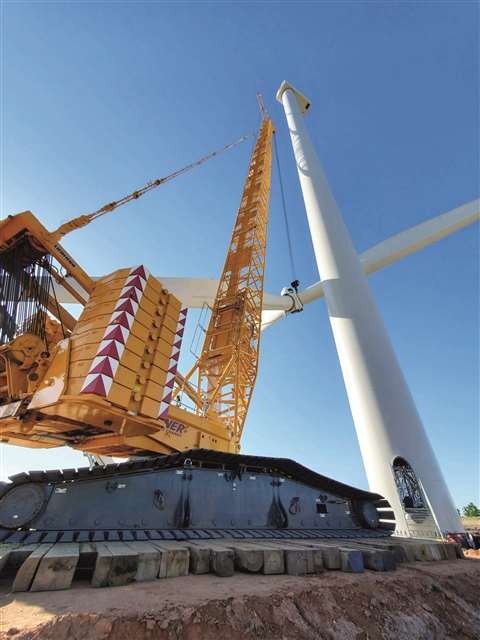 To get involved in the wind power market, smaller crane companies are buying larger capacity cranes.
To get involved in the wind power market, smaller crane companies are buying larger capacity cranes.
Have you seen a proliferation of financing for cranes that will be used specifically in the wind market?
We are seeing more requests for larger capacity cranes used in turbine erection and maintenance, and we are seeing more requests from smaller companies than in the past. Traditionally, the ownership of these cranes was limited to a select few of the top 10 largest crane rental companies, and now we are seeing interest from a larger group of the ACT100 list of the largest crane rental companies.
Generally, in the financing of these cranes, are there certain parameters that a crane owner needs to meet?
As you can imagine, it is more challenging for a company with between $50 million and $100 million in revenues to acquire a crane of this size and secure financing for it. We have successfully financed in what we call the “middle market,” because we believe strongly in the wind energy industry, and it aligns with our own corporate values and ESG initiatives (which are based on World Bank Group’s IFC Performance Standards).
Generally, an ACT100 company could expect to be able to secure financing for a crane of this size if they generate sufficient cash flow from operations to cover the required debt service and they have a strong balance sheet characterized by a debt to equity ratio less than 6:1. We will almost always recommend either a lease with a fixed price purchase option or a longer term (84 to 96 months) so the revenue and expense sides line up profitability for our client.
STAY CONNECTED


Receive the information you need when you need it through our world-leading magazines, newsletters and daily briefings.



